Jensen MP6211 User Manual
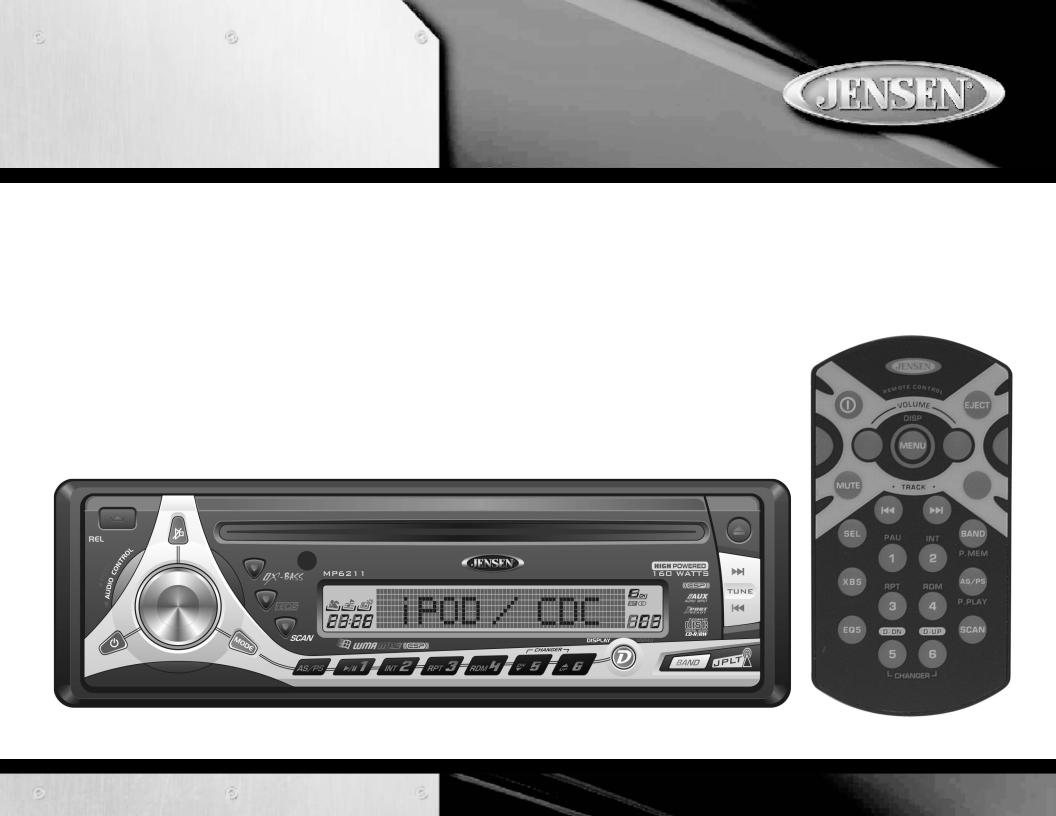
MP6211
Instruction Manual Manual de Instrucciones Guide d'instructions

MP6211
TABLE OF CONTENTS |
|
Introduction .............................................................................................. |
1 |
Preparation .............................................................................................. |
2 |
Wiring ....................................................................................................... |
3 |
Installation ................................................................................................ |
4 |
Operation ................................................................................................. |
6 |
Tuner Operation ....................................................................................... |
9 |
CD Player Operation .............................................................................. |
10 |
MP3/WMA Operation ............................................................................. |
11 |
CD Changer Operation .......................................................................... |
13 |
JPORT Operation .................................................................................. |
13 |
Remote Control ...................................................................................... |
14 |
Care and Maintenance ........................................................................... |
14 |
Troubleshooting ..................................................................................... |
15 |
Specifications ......................................................................................... |
15 |
12-Month Limited Warranty .................................................................... |
16 |
CONTENIDO |
|
Introducción ........................................................................................... |
17 |
Preparación ............................................................................................ |
18 |
Cableado ................................................................................................ |
19 |
Instalación .............................................................................................. |
20 |
Operación .............................................................................................. |
22 |
Operación de la Radio ........................................................................... |
25 |
Operación del Reproductor de CD ......................................................... |
26 |
Operación de MP3/WMA ....................................................................... |
27 |
Operación del Cambiador de CD ........................................................... |
29 |
Operación del JPORT ............................................................................ |
30 |
Control Remoto ...................................................................................... |
30 |
Cuidado y Mantenimiento ...................................................................... |
30 |
Corrección de Problemas ...................................................................... |
31 |
Especificationes ..................................................................................... |
31 |
Garantia Limitade de 12 Meses ............................................................. |
32 |
TABLE DES MATIÈRES |
|
Introduction ............................................................................................ |
33 |
Préparation ............................................................................................ |
34 |
Câblage ................................................................................................. |
35 |
Installation .............................................................................................. |
36 |
Opération ............................................................................................... |
38 |
Fonctionnement de la radio ................................................................... |
41 |
Fonctionnement du lecteur CD .............................................................. |
42 |
Fonctionnement de MP3/WMA .............................................................. |
43 |
Opération de changeur de CD ............................................................... |
45 |
Opération JPORT .................................................................................. |
45 |
Prêt à être télécommandé ..................................................................... |
46 |
Soin et entretien ..................................................................................... |
46 |
Dépannage ............................................................................................ |
47 |
Specifications ......................................................................................... |
47 |
Garantie limitée de 12 mois ................................................................... |
48 |
i

MP6211
ii

MP6211
INTRODUCTION
Congratulations on your purchase of the Jensen MP6211 Mobile Receiver. It’s a good idea to read all of the instructions before beginning the installation. We recommend having your Jensen MP6211 installed by a reputable installation shop.
Features
MP3 / WMA
•MP3 / WMA- CD-R/RW compatible
•ID3 tag compatible
•MP3 / WMA quick file search via rotary volume knob
•MP3 / WMA song surfing
•MP3 / WMA file search by title, artist or folder
•MP3 / WMA direct track access
•Supports up to 32 characters for file or folder names
•MP3 / WMA “loaded/inserted” icon
•High-speed audible fast forward/rewind
•MP3 100-second ESP - Electronic Skip Protection
•WMA 200-second ESP - Electronic Skip Protection
•16MB SDRAM buffer
CD
•Last position memory
•Random/repeat/intro
•High-speed audible track search
•1-Bit D/A converter
•Anti-shock mechanism
•40-second ESP - Electronic Skip Protection
AM/FM Tuner
•World Tuner
•30 station presets (18 FM/12AM)
•JENSEN Plus Tuner II
•Auto station store
•Preset scan
•One-touch memory
•Auto stereo/mono
•Manual local/distance
•Manual tuning up/down
•Auto seek tuning up/down
•5-second scan tuning
Chassis
•Electronic detachable faceplate
•1.0 DIN
•Import ISO/DIN mountable
•20-pin power harness
General
•iAUX and JPORT ready (see “Optional Accessories”)
•User friendly setup menu
•LCD contrast control
•LCD dimmer control
•Clock
•Selectable display priority
•Switchable bi-color preset illumination – red or blue
•Infrared remote control (included)
•IR30 Steering Wheel Remote Control compatible (sold separately)
•High contrast positive Liquid Crystal Display (LCD)
•Electronic volume, bass, treble, balance, fader
•Rotary encoder audio control
•Programmable turn-on volume
•Multi-button power on
•Keyless CD eject
•1 pair Rear pre-amp outputs
•5V Peak / 2V RMS RCA pre-amp output voltages
•200-ohm low impedance preamp output
•1 subwoofer pre-amp output (RCA) (adjustable level control)
•200Hz low pass subwoofer crossover
•1 pair rear RCA auxiliary input
•Flex-Fader
•iEQ5 – instant EQ
•5-selectable iEQ curves – Beat, Jazz, Classic, Pop and Rock
•iX-Bass – instant eXtended bass
•Mute
•Hard carry case
Optional Accessories
iAUX READY (Sold Separately)
•Can connect to any portable media device or multimedia device using a standard 3.5mm plug
•Converts 3.5mm auxiliary input to RCA stereo outputs for easy connection to the radios Aux inputs
JPORT READY (Sold Separately)
•Controls all iPod’s except “Shuffle” (audio only)
•CD changer pass-thru input
•Plug both the iPod and CD changer in at the same time (operates independently)
•APPLE® approved iPod interface cable (Included with jPort Adapter Module)
1
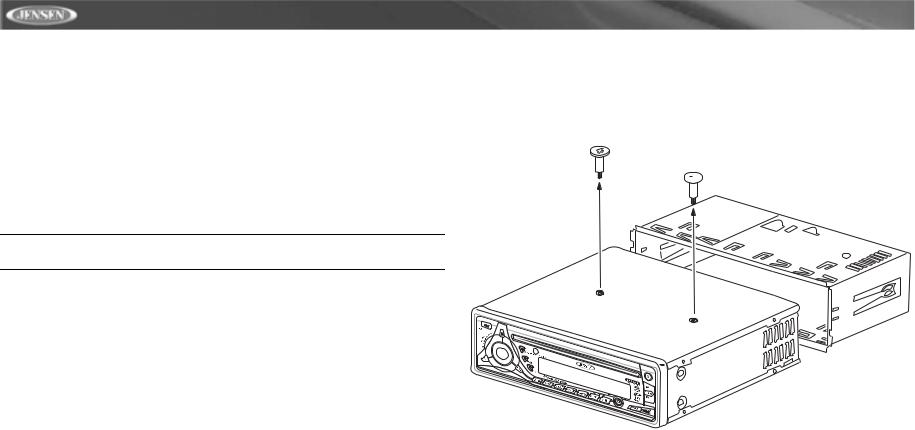
PREPARATION
Tools and Supplies
The following tools and supplies are needed to install the radio.
•Torx type, flathead and Philips screwdrivers
•Wire cutters and strippers
•Tools to remove existing radio (screwdriver, socket wrench set or other tools)
•Electrical tape
•Crimping tool
•Volt meter/test light
•Crimp connections
•18 gauge wire for power connections
•16-18 gauge speaker wire
SPEAKER REQUIREMENTS: Only connect speakers rated in the load impedance of 4 ohms. Speakers with a load impedance less than 4 ohms could damage the unit.
MP6211
Pre-installation
1.Disconnect Battery
Before you begin, always disconnect the battery negative terminal.
2.Remove Transport Screws
3.Remove Radio from Sleeve
Lift latches on both sides of sleeve to remove half-sleeve from radio.
TRANSPORT 
SCREWS
HALF
SLEEVE
2
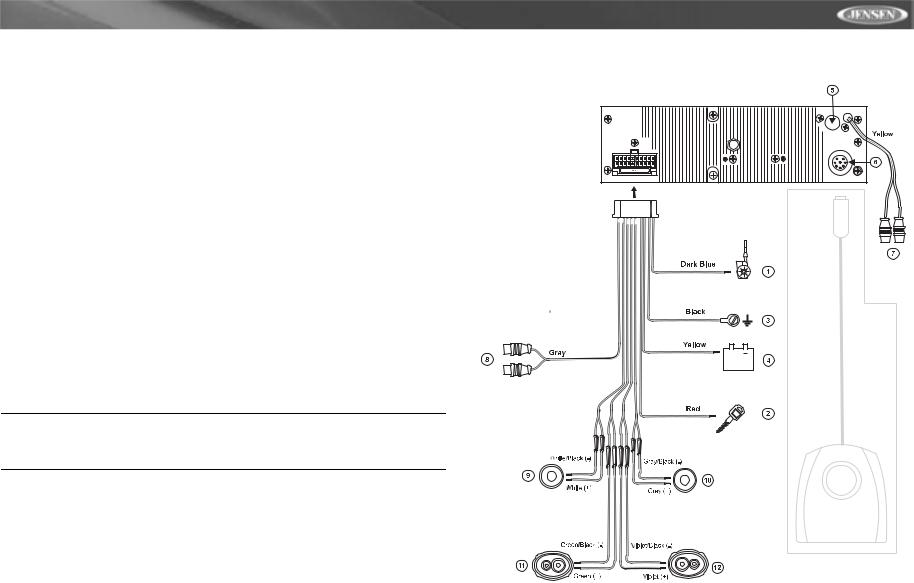
MP6211
WIRING
WIRING DIAGRAM
Wiring with a Wiring Adapter (Purchased Separately)
Connect Wires
You can make these connections without being in the vehicle.
1.Splice or crimp wires.
2.Attach wiring adapter to car wiring harness.
Wiring Diagram / Color Codes
1.Power Antenna (dark blue wire) - Connect to power antenna or amplifier. If not used, tape bare end of wire.
2.Accessory/Ignition (red wire) - Connect to existing radio wire or radio fuse.
3.Ground (black wire) - Connect to ground terminal or clean, unpainted part of chassis.
4.Memory/Battery (yellow wire) - Connect to battery or 12 volt power source that is always live. The radio will not work if this wire is not connected.
5.Antenna Connector - Connect the antenna plug from the existing antenna cable (some vehicles require an adaptor).
6.CD Changer/JPORT connector - Use this 8-pin DIN socket to connect an optional CD Changer or JPORT (sold separately).
7.Auxiliary Input Cable (yellow RCA cables) - Connect line in for auxiliary input devices (CD player, etc.).
8.Outputs to Amplifier (gray RCA cables) - Connect line out for optional external amplifiers. The red connector is for the right and the white connector is for the left.
9.Left Front Speaker
10.Right Front Speaker
11.Left Rear Speaker
12.Right Rear Speaker
NOTE: The amplifier in this radio is only designed for use with four speakers. Never combine (bridge) outputs for use with two speakers. Never ground negative speaker leads to chassis ground. Failure to wire exactly as shown may cause electrical damage to the radio.
Fuses
When replacing a fuse, make sure the new fuse is the correct type and amperage. Using an incorrect fuse could damage the radio. The MP6211 uses one 15 amp fuse located below the wiring connector (15 amp fast blow ATO).
Reconnect Battery
When wiring is complete, reconnect the battery negative terminal.
Technical Assistance
Optional JPORT
(Sold Separately)
If you require assistance, contact Technical Support at 1-800-323-4815 from 8:30am to 7:00pm EST Monday through Friday and from 9:00am to 5:00pm EST on Saturday.
3
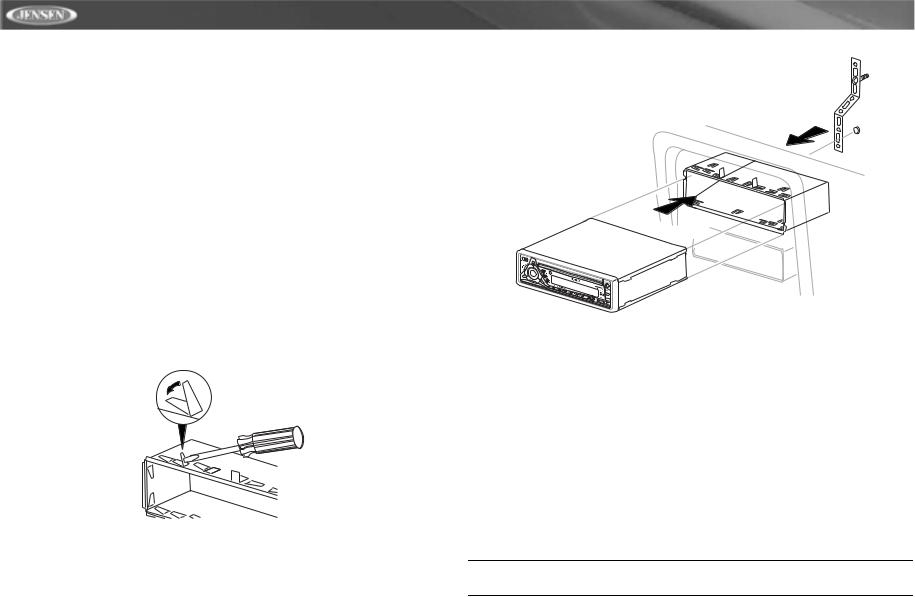
INSTALLATION
This unit is designed for installation in cars, trucks and vans with an existing radio opening. In many cases, a special installation kit will be required to mount the radio to the dashboard. These kits are available at electronics supply stores and car stereo specialty shops. Always check the kit application before purchasing to make sure the kit works with your vehicle. If you have trouble locating a kit or need installation assistance, contact Technical Support at 1-800- 323-4815 from 8:30am to 7:00pm EST Monday through Friday and from 9:00am to 5:00pm EST on Saturday.
Universal Installation Using Mounting Sleeve
1.Remove the detachable front panel, if it is attached to the chassis, by pushing the “Release” button.
2.Slide the mounting sleeve off of the chassis if it has not already been removed. If it is locked into position, use the removal keys (supplied) to disengage it. The removal keys are depicted on page 5.
3.Check the dashboard opening size by sliding the mounting sleeve into it. If the opening is not large enough, carefully cut or file as necessary until the sleeve easily slides into the opening. Do not force the sleeve into the opening or cause it to bend or bow. Check that there will be sufficient space behind the dashboard for the radio chassis.
4.Locate the series of bend tabs along the top, bottom and sides of the mounting sleeve. With the sleeve fully inserted into the dashboard opening, bend as many of the tabs outward as necessary to firmly secure the sleeve to the dashboard.
5.Place the radio in front of the dashboard opening so the wiring can be brought through the mounting sleeve.
MP6211
6.Follow the wiring diagram carefully and make certain all connections are secure and insulated with crimp connectors or electrical tape to ensure proper operation.
7.After completing the wiring connections, attach the front panel and turn the unit on to confirm operation (vehicle ignition switch must be on). If the unit does not operate, recheck all wiring until the problem is corrected. Once proper operation is achieved, turn the ignition switch off and proceed with final mounting of the chassis.
8.Carefully slide the radio into the mounting sleeve making sure it is right-side-up until it is fully seated and the spring clips lock it into place.
9.Attach one end of the perforated support strap (supplied) to the screw stud on the rear of the chassis using the hex nut provided. Fasten the other end of the perforated strap to a secure part of the dashboard either above or below the radio using the screw and hex nut provided. Bend the strap, as necessary, to position it. CAUTION: The rear of the radio must be supported with the strap to prevent damage to the dashboard from the weight of the radio or improper operation due to vibration.
10.Re-attach the front panel to the chassis and test radio operation by referring to the operating instructions for the unit.
NOTE: For proper operation of the CD player, the chassis must be mounted within 20° of horizontal. Make sure the unit is mounted within this limitation.
4
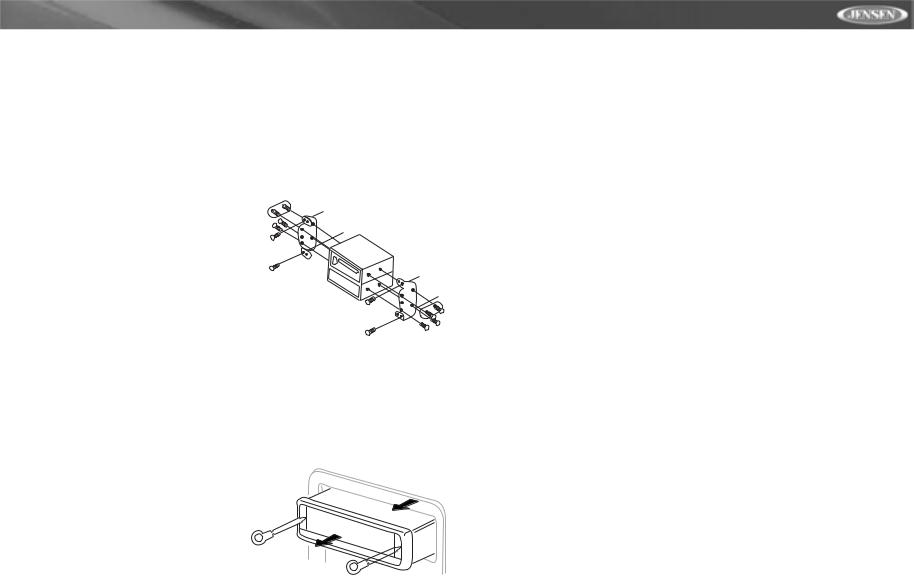
MP6211
Kit Installation
If your vehicle requires the use of an installation kit to mount this radio, follow the instructions included with the installation kit to attach the radio to the mounting plate supplied with the kit.
1.Wire and test the radio as outlined in the Universal Installation instructions.
2.Install the radio/mounting plate assembly to the sub-dashboard according to the instructions in the installation kit.
3.Attach the support strap to the radio and dashboard as described in the Universal Installation instructions.
4.Replace the dashboard trim panel.
ISO Installation
This unit has threaded holes in the chassis side
panels which may be used with the original factory mounting brackets of some vehicles to mount the radio to the dashboard. Please consult with your local car stereo shop for assistance on this type of installation.
1. Remove the existing factory radio from the dashboard or center console mounting. Save all hardware and brackets as they will be used to mount the new radio.
2. Carefully unsnap the plastic frame from the
front of the new radio chassis. Remove and discard the frame.
3.Remove the factory mounting brackets and hardware from the existing radio and attach them to the new radio. Do not exceed M5 x 9 MM maximum screw size. Longer screws may damage components inside the chassis.
4.Wire the new radio to the vehicle as outlined in the Universal Installation instructions.
5.Mount the new radio assembly to the dashboard or center console using the reverse procedure of step 1.
Remove Radio
To remove the radio after installation, remove the trim ring by lifting in the center and pulling it off from either side. Insert the removal keys straight back until they lock, and then pull the radio out. If removal keys are inserted at an angle, they will not
lock properly to release the unit.
REMOVAL KEYS 
5
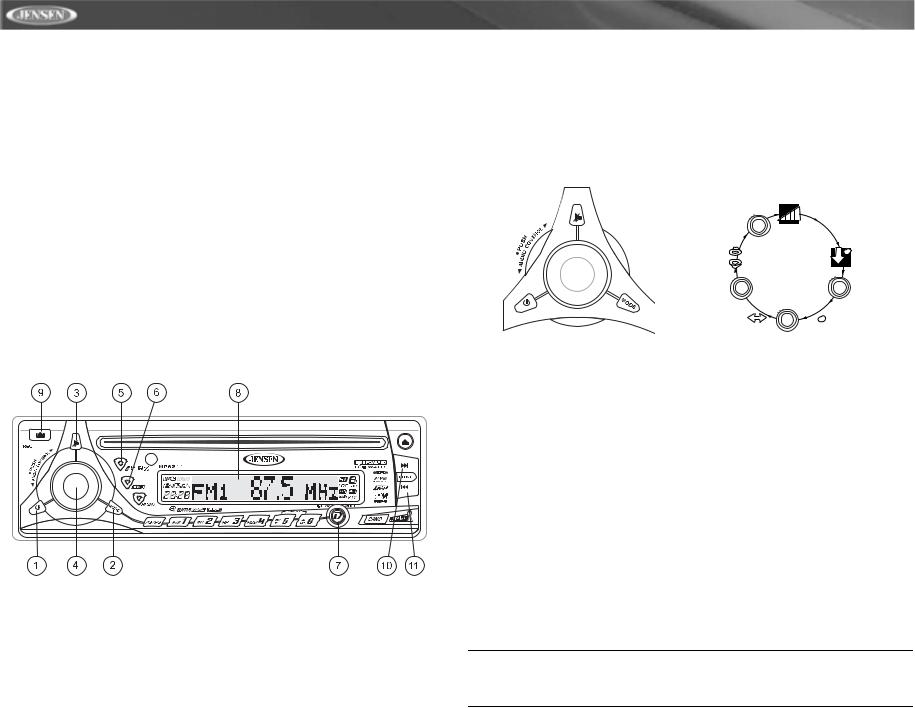
OPERATION
Power
Press the power button (1) or any other button on the front of the radio (except Eject) to turn the unit on. Press the power button again to turn the unit off.
Mode
Press MODE (2) to select a different mode of operation, as indicated on the display panel. Available modes include tuner (F1, F2, F3, AM), CD, CD changer (if connected) and auxiliary (AUX). CD mode appears in the menu only if a CD is present in the CD player. CD changer mode appears only if a CD changer is connected to the unit.
Audio Mute
Press the mute  button (3) to silence the audio volume. “Mute” flashes in the display. Press mute
button (3) to silence the audio volume. “Mute” flashes in the display. Press mute  again to restore volume to the previous setting.
again to restore volume to the previous setting.
Volume / Audio Control
To increase the volume, rotate the volume control (4) clockwise. To decrease the volume, rotate the volume control counter-clockwise. When volume is adjusted, the volume level will be shown on the display panel as a number ranging from “0” (lowest) to “46” (highest).
Press the volume control repeatedly to step through the following audio functions: volume (VOL), bass (BAS), treble (TRB), balance (BAL), fader (FAD) and back to volume. The unit automatically exits audio control mode after five seconds of inactivity.
Bass
To adjust the bass level from “-6” to “+6”, press the volume control until “BAS” appears in the display. Rotate the control clockwise to increase or counter-clockwise to decrease the bass. “0” represents a flat response.
Treble
To adjust the treble level from “-6” to “+6”, press the volume control until “TRB” appears in the display. Rotate the control clockwise to increase or counter-clockwise to decrease the treble. “0” represents a flat response.
MP6211
Balance
To adjust the balance from “L12” (full left) to ”R12” (full right), press the volume control until “BAL” appears in the display. Rotate the control clockwise or counter-clockwise to adjust the balance between the left and right speakers. “C00” represents a center balance.
Fader
To adjust the fader from “F12” (full front) to “R12” (full rear), press the volume control and rotate it clockwise or counter-clockwise to adjust the fader between the front and rear speakers. “C00” represents a center fader level.
VOL
VOL
|
|
FAD |
|
|
STRE |
AB |
L |
B A |
|
L
E
TC
FAD 
TREFAD
BAL
BAS
L
E
TC
BAL

RTEFAD
|
ABS |
AB |
L |
 BAS
BAS
|
STR |
EFAD |
L |
B A |
|
B A |
|
|
L
E
TC
 TRB
TRB
L
E
TC
iX-Bass
Press iX-BASS (5) to activate the iX-BASS feature. When listening to music at low volume levels, this feature will boost the bass and treble ranges to compensate for the characteristics of human hearing. When this feature is activated, “iX-BASS On” will appear in the display. Press iX-BASS again to select “iX-BASS Off”. The iXBS icon will appear and remain in the display when the iX-BASS feature is activated.
Equalizer Selector
The equalizer function applies preset sound effects to the unit’s audio output signal. Press iEQ5 (6) to step through the following equalizer options: “Pop”, “Jazz”, “Classic”, “Beat”, “Rock”, and “Off”. The equalizer options appear in the display as they are accessed.
When the equalizer function is activated, the most recently selected bass/treble levels cannot be adjusted. When the equalizer function is not active, the unit will return to the most recently selected bass and treble levels.
Liquid Crystal Display (LCD)
The liquid crystal display (LCD) panel (8) displays the frequency, time and activated functions of the unit, including a combination audio level/disc indicator, which appears as dual disc icons with circular bar graphs depicting the audio signal. In addition, the display contains a receive signal indicator that depicts the relative strength of the incoming broadcast frequency.
NOTE: LCD panels may take longer to respond when subjected to cold temperatures for an extended period of time. In addition, the visibility of the numbers on the LCD may decrease slightly. The LCD display will return to normal when the temperature increases to a normal range.
6

MP6211
Menu Operation
A second function of DISPLAY / MENU, is to access a menu of radio options. Press DISPLAY / MENU for more than three seconds to access the menu. “Menu” will appear in the display. Navigate the menu by pressing DISPLAY / MENU to move forward to the next option.
The menu can also be navigated by using the Up Tuning (10) or Down Tuning (11) button to move to the next or previous option. Once the desired option appears in the display, adjust that option by rotating the volume control within five seconds. The following options are adjusted through this menu feature:
Contrast
The contrast level of the display is set at “CONTRAST 05” by default. Rotate the volume control to adjust the contrast level from “00” to “10”.
Dimmer
The dimmer feature of the display is set to “DIMMER High” by default. Rotate the volume control to turn the dimmer to the low setting.
Clock Format
This option allows selection of a 12 hour or 24 hour clock format. “CLK FORMAT 12H” is the default setting. Rotate the volume control to change to the 24 hour clock format.
Time Set
The time on the clock will be set to “12:00” as the default. Program the current time by rotating the volume control clockwise to adjust the minutes and counter-clockwise to adjust the hours.
Local / Distance Selector
This feature is used to designate the strength of the signals at which the radio will stop during automatic tuning. “Distant” is the default, allowing the radio to stop at a broader range of signals. To set the unit to select only strong local stations during automatic tuning, rotate the volume control to select “Local”. “LOC” appears in the display.
Frequency Spacing
This option allows the selection of the frequency spacing appropriate for your area. “AREA U.S.A.” is the default setting. Rotate the volume control to select the “Latin”, “Europe” or “Oirt” options.
Programmable Turn-on Volume
Use the “VOL PGM” option to select the default volume the radio will assume when first turned on. To program a specific start-up volume level, rotate the volume control to select the desired level.
Beep Tone
The beep tone feature allows the selection of an audible beep tone to be heard each time a button is pressed on the face of the radio. “BEEP TONE On” is the default display. Rotate the volume control to select the “BEEP TONE Off” option.
Illumination Color
The “COLOR” option allows selection between two colors for the backlight illumination of the unit. “COLOR 1” is the default display and will illuminate the unit in blue backlight. Rotate the volume control to select “COLOR 2”, which will illuminate the display in red backlight.
Selectable Clock Display
When the selectable clock display (CLK ON LCD) feature is activated, the clock and default greeting note will appear in the display when the radio is turned off but still connected to the ignition wire. “CLK ON LCD On” is the default display for this option. To select that the clock and greeting not be displayed when the unit is powered off, rotate the volume control to select “CLK ON LCD Off”.
Key Light On/Off
When the key light feature is activated (ON) the preset buttons and the rest of the front panel function buttons remain lit when the unit is turned off, but the ignition key remains on. Turn the volume control to select “Key Light Off” if you would prefer the buttons not remain illuminated when the unit is off.
Personal Text Message
The personal text message (PTM) feature allows you to enter a personal message up to 20 characters (including spaces) using the letters A-Z, the numbers 0-9 and the symbols “_”, “+”, “-” and “!”. Press in on the volume control to access this option from the menu, then rotate the volume control to select the first character for your message. Once you have selected your first
7
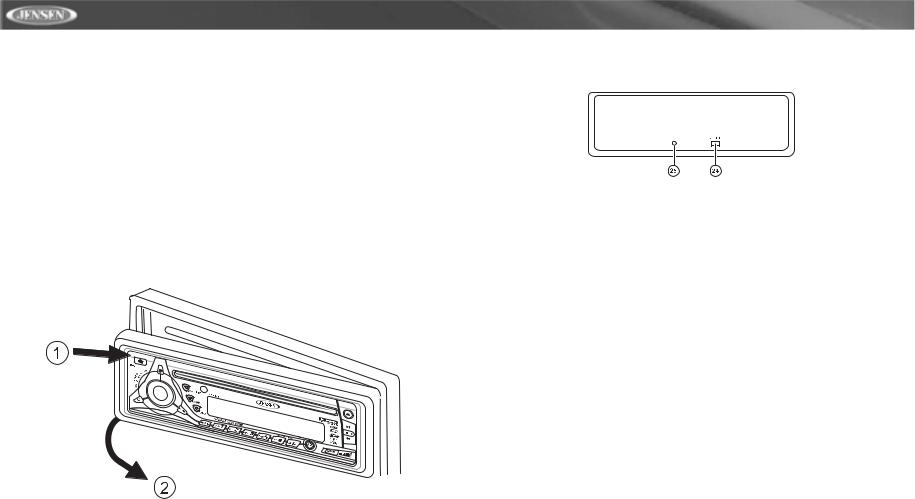
character, press in on the volume control to move to the next space and select the next character. To leave a blank space, press the volume control again.
Greeting Note
When the unit is powered on, one of three greetings is displayed based on the time of day: “Good Morning”, “Good Afternoon” or “Good Evening”. When the unit is powered off with the ignition on, the LCD scrolls through the following messages (if the selectable clock display feature is activated): “Radio Off”, “Visit us at Jensen.com”, “Enjoy Driving and Have a Safe Trip”.
Front Panel Release
The front panel release button (9) releases the mechanism that holds the front panel to the chassis.
Detaching the Front Panel
To detach the front panel, first press the front panel release button to release the left side of the panel. Next, grasp the released side and pull it off the chassis. After removing the front panel, store it in the supplied carrying case to protect it from dirt and damage.
REMOVE FRONT PANEL
Re-attaching the Front Panel
To re-attach the front panel, make sure the electrical terminals on the back of the panel are free of dust and dirt, as debris could cause intermittent operation or other malfunctions. Position the right side of the panel in place so that it is correctly engaged, then lightly press the left side of the panel until the mechanism locks it into place.
Reset Button
The RESET button (24) is located on the front of the chassis and can only be accessed with the front panel removed. The reset circuitry protects the microprocessor circuitry. Since resetting the unit will erase the time and preset memories, it should only be activated upon initial installation after all wiring is complete or if there is a malfunction of any of the switches on
MP6211
the unit. In these circumstances, pressing the RESET button will clear the system and return the unit to normal operation.
Theft Deterrent LED
A light-emitting diode (LED) (25) is located on the chassis behind the front panel and will flash when the panel is removed. The flashing light serves as a visual warning to the would-be thief that the unit has been disabled by removal of the front panel.
8
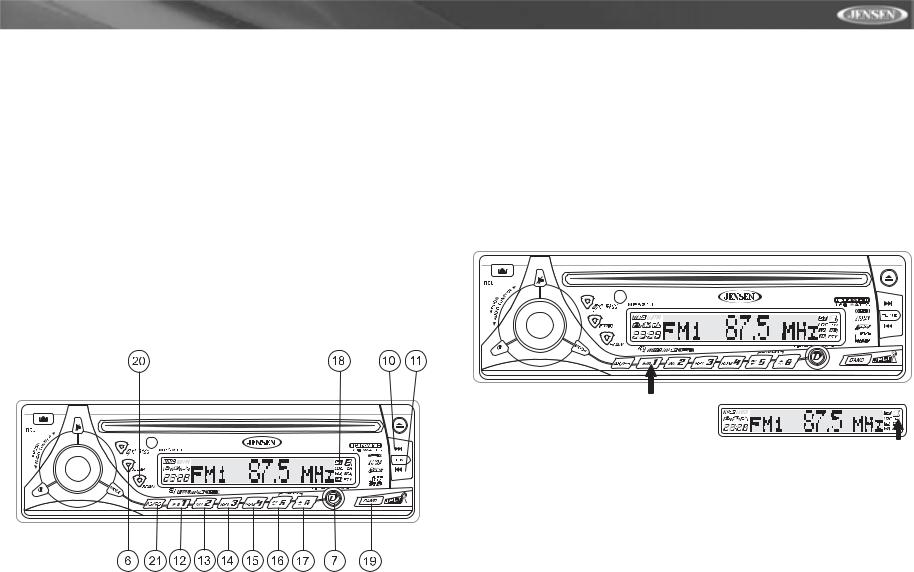
MP6211
TUNER OPERATION
The MP6211 comes equipped with a World Tuner, allowing you to receive channels in USA, EUROPE, LATIN, & OIRT (Russia). See “Frequency Spacing” on page 7 to learn how to change the World Tuner options.
Select a Band
Press BAND (19) to change between three FM bands and two AM bands. Each band stores up to six preset stations.
Tuning
Manual Tuning
Press the Up Tuning (10) or Down Tuning (11) button for more than three seconds to enter manual tuning mode, then press the Up Tuning or Down Tuning buttons to move the radio frequency number up or down one step.
Auto Seek Tuning
Press the Up Tuning (10) or Down Tuning (11) button for less than three seconds to move to next station automatically.
Scan
Press SCAN (20) to scan through strong stations in the current band. The radio pauses for five seconds at each strong station. Press SCAN again to listen to the current station.
Preset Stations
Up to six stations on each band can be stored as presets and can then be instantly recalled by pressing the associated preset button (12-17). To store a station, turn the radio on and select the desired band and station. Press and hold the desired preset button (numbered one through six on the face of the radio) for more than two seconds. When stored, the preset number will appear in the display. The station is now stored and can be re-called at any time by pressing the corresponding preset button. Repeat for the remaining five presets on the current band and for all presets on the other three bands.
Automatically Store / Preset Scan (AS/PS)
Automatically Store
Select six strong stations and store them in the current band using the Automatic Store feature. To enable this feature, press and hold AS/PS (21) for more than two seconds. The radio will automatically scan the band in use and enter strong stations into the preset memory positions for that band. After entering the stations into memory, the unit will automatically stop at each station for five seconds so each can be heard. When using the Automatically Store feature, the new stations replace any stations already stored in preset memory for the selected band.
Preset Scan
Press AS/PS (21) to scan the six preset stations in the current band. The unit will stop at each station for five seconds before continuing to the next preset station, and the preset number will flash on the display during the preset scan. Press AS/PS again to stop scanning and listen to the current station.
PRESS AND HOLD
PRESET NUMBER APPEARS
Stereo
The unit will automatically pick up a stereo signal, when available. When in stereo mode, the “ST” icon (18) appears in the display. When no stereo signal is available, the unit will automatically revert to mono operation, and no icon will be displayed.
9

CD PLAYER OPERATION
Insert and Eject CD
Insert a CD label side up. To stop CD play and eject the CD, press the eject button (22).
NOTE: The unit is designed for play of standard 5” (12 cm.) compact discs only. Do not attempt to use 3” (8 cm.) CD singles in this unit, either with or without an adaptor, as damage to the player and/or the disc may occur. Such damage will not be covered by the warranty on this product.
Pause
Press the pause button (12) to suspend disc play. Press the pause button again to resume disc play.
Track Select
Press the Up Tuning (10) or Down Tuning (11) button for less than one second to advance to the next track on the CD. The selected track number will appear on the display. Press and hold the Up Tuning (10) or Down Tuning (11) button for more than one second to fast forward or fast reverse through the disc. CD play starts when the button is released.
Intro Scan (SCN)
During disc play, press SCN (13) to play the first 10 seconds of each track on the disc. When the desired track is reached, press SCN again to end the scan and play the selected track.
Repeat (RPT)
Press RPT (14) during disc play to continuously repeat the track. Press RPT again to stop repeating.
Random (RDM)
Press RDM (15) during disc play to play all tracks on a CD in random, shuffled order. Press RDM again to stop random play.
Display CD Text
Press AS/PS (21) to display any text encoded on the CD (song title, artist, etc.).
MP6211
CD Player Error Codes
If a problem should develop while operating the CD player, an error code (ER-1, ER-2, etc.) may appear on the display panel. This can indicate a number of problems with the unit, including a mechanical error or an error in the microprocessor control of the player. If an error code should appear, try ejecting and reloading the disc into the player. While the disc is out of the unit, make sure it is clean and undamaged, and then load it correctly. If this does not solve the problem, pressing the RESET button (24) may help, but will erase the time and preset memory. If the suggested measures do not solve the problem, contact an approved warranty station near you for further assistance.
10

MP6211
MP3/WMA OPERATION
MP3 and WMA (Windows Media Audio) music files are digital audio files that are compressed to allow more files on a single CD. This unit can play MP3/WMA directly from files contained on a CD-R/RW using the buttons on the receiver (or optional remote) as described below. Many types of software are available for converting audio files into MP3/WMA formats. Jensen recommends Nero, MusicMatch Jukebox or Roxio Easy CD Creator. Depending on the media type and recording method, some CD-R/RW's may be incompatible with this unit. The unit supports playback of MP3/WMA and CDDA (CDA), Mixed-Mode CDs and CD-Extra (including multi-session discs), but discs on which the session has not been closed will not play.
Notes on MP3/WMA Play
This unit can play MP3 (MPEG1, 2, 2.5 Audio Layer 3). However, the MP3 recording media and accepted formats are limited. When writing MP3/WMA, pay attention to the following restrictions.
Acceptable Media
The MP3/WMA recording media acceptable to this unit are CD-ROM, CD-R and CD-RW. When using CD-RW, use full format rather than quick format to prevent malfunction.
Acceptable Medium Formats
The following formats are available for the media used in this unit. The maximum number of characters used for file name including the delimiter (".") and three-character extension are indicated in parentheses.
•ISO 9660 Level 1 (11 characters)
•ISO 9660 Level 2 (31 characters)
•Joliet (31 characters)
•Romeo (31 characters)
Up to 200 characters can be displayed in the long file name format. For a list of available characters, see the instruction manual of the writing software and the section “Entering File and Folder Names” below. The media reproducible on this unit has the following limitations:
•Maximum number of nested folders: 8
•Maximum number of files per disc: 999
•Maximum number of folders per disc: 255
MP3/WMA written in formats other than those listed above will not play successfully and their file names or folder names will not be display properly.
MP3/WMA Encoder and CD Writer Settings
Use the following settings when compressing audio data in MP3 data with the MP3 encoder.
•Transfer bit rate : 8 - 320 kbps
•Sampling frequency : 8, 11.025, 12, 16, 22.05, 24, 32, 44.1, 48 kHz
When using a CD writer to record MP3/WMA up to the maximum disc capacity, disable additional writing. To record an empty disc up to the maximum capacity at once, select the “disc at once” option.
Entering ID3 Tag
This unit supports ID3 tag versions 1.0 and 1.1. For the character codes, refer to the table to the right. The unit also supports CD-TEXT encoded discs for Album, Track and Artist Title information.
Entering File and Folder Names
Names using the code list characters are the only file names and folder names that can be entered and displayed. Using any other character will cause the file and folder names to be displayed incorrectly. The unit recognizes and plays only files with the MP3/WMA extension.
NOTE: A file name entered with characters not on the code list may not play correctly.
Writing Files into a Medium
When a medium containing MP3/WMA data is loaded, the unit checks all data. If the medium contains many folders or non-MP3/WMA files, MP3/WMA play will be delayed, it may take time for the unit to move to the next file, and searches may not be performed smoothly. Loading such a medium may produce loud noise and cause damage to the speakers. Do not attempt to play a medium containing a non-MP3/WMA file with the MP3/WMA extension or a medium containing non MP3/WMA files.
Electronic Shock Protection
•40 seconds for CDDA (CDA)
•120 seconds for MP3 recorded at 44.1kHz, 128kbps
•200 seconds for WMA recorded at 44.1kHz, 128kbps
Bit Rates
The unit supports bit rates from 32 - 320 kbps.
MP3 Playing Order
When selected for play, files and folders (Folder Search, File Search or Folder Select) are accessed in the order they were written by the CD writer. As a result, the order in which they are expected to be played may not match the order in which they are actually played. You may be able to set the order in which MP3/WMA are to be played by writing them onto a medium such as a CD-R with their file names beginning with play sequence numbers such as "01" to
11
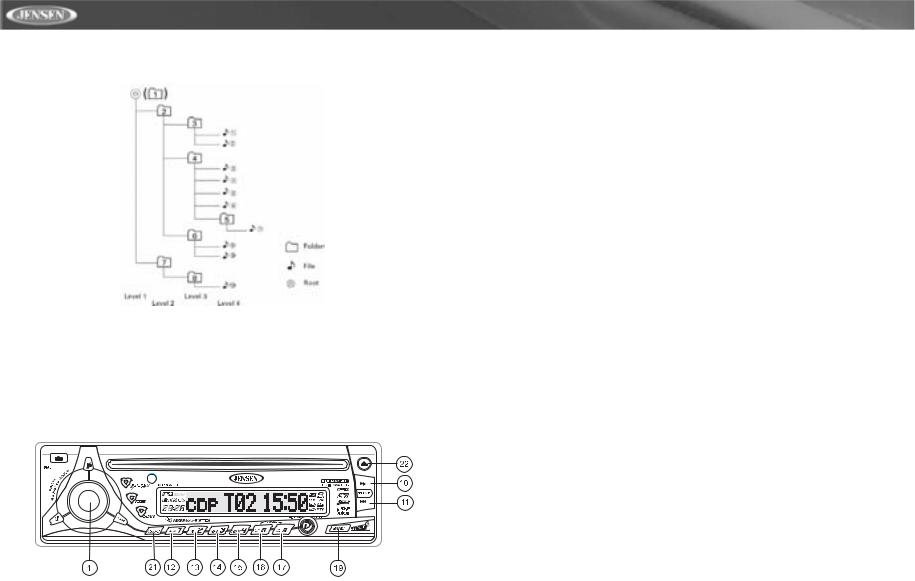
"99". For example, a medium with the following folder/file hierarchy is subject to Folder Search, File Search or Folder Select as shown below.
Languages
The unit supports playback of the following seven languages: English, French, German, Portuguese, Spanish, Italian and Dutch.
Loading an MP3/WMA Disc
Press the eject button (22) to lower the front panel, then Insert an MP3/WMA disc. After the disc is loaded, the track number and elapsed time will appear, then the display will scroll through any ID3 Tag information while the file is playing.
Pause
Press the pause button (12) to suspend disc play. Press the pause button again to resume disc play.
Accessing the ID3 Tag
Press AS/PS (21) repeatedly during MP3/WMA play to access the ID3 information manually. The display will show any of the following information that is programmed on the disc: Folder Name, File Name, Album Title, Track Title, Artist Title.
MP6211
Track Select
Press the Up Tuning (10) or Down Tuning (11) button for less than one second to advance to the next track on the disc, or for more than one second to fast forward or fast reverse through the disc. Disc play starts when the button is released.
Navigating Folders
Press the Folder Down (16) button (also the “5” button) to skip to the next folder, or press the Folder Up (17) button (also the “6” button) to return to the previous folder.
Intro Scan (SCN)
During disc play, press SCN (13) to play the first 10 seconds of each track on the disc. When the desired track is reached, press SCN again to end the scan and play the selected track. Press SCN for more than three seconds to play the first 10 seconds of each track in the current folder. When the desired track is reached, press SCN again for more than three seconds to end the scan and play the selected track.
Repeat (RPT)
Press RPT (14) to repeatedly play the current file. Press RPT again to resume normal play. Press RPT for more than three seconds to repeatedly play all files in the current folder. Press RPT again for more than three seconds to resume normal play.
Random (RDM)
Press RDM (15) to randomly play all files on the disc. Press RDM again to resume normal play. Press RDM for more than three seconds to randomly play all files in the current folder. Press RDM again for more than three seconds to resume normal play.
MP3/WMA File or Folder Search
The unit offers three methods of searching for files or folders on a disc.
Direct File Number Search
Press BAND (19). The LCD will display "Number", and the illumination around the select knob
(4) will blink. Rotate the knob to select the desired track number, then press in on the knob to confirm and play the selected file.
Navigation Search
Press BAND (19) twice. The LCD will display "Navigate", and the illumination around the select knob (4) will blink. Rotate the knob to navigate through all folders and sub-folders on the disc. The folder names will be displayed on the LCD. Press the select knob for more than three seconds to play the first file in the folder. Press the select knob for less than three seconds to access the sub-folders or files. Rotate the select knob to navigate, then press the select knob to confirm and begin file play. During navigation search, press AS/PS or rotate the select knob counter-clockwise to move back to the last upper level of a folder.
Direct Alphabet Search
Press BAND (19) three times. The LCD will display "Alphabet", and the illumination around the select knob (4) will blink. Rotate the select knob to choose a character, including letters A-Z, numbers 0-9 and the symbols “_”, “-”, “+” and “!”. Press the select knob to confirm entry and move to the next character space. The unit will also search for matching file or folder names when only the first few characters are entered. Rotate the select knob to navigate the files or folders, then press the select knob to confirm and play file.
12
